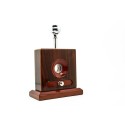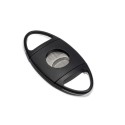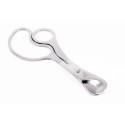Cigar cutting
Cigar cutting is a crucial, must-do step in cigar smoking. A good cut can greatly affect the smoking experience: if done incorrectly, it can irreparably ruin the cigar!
This guide will walk you through the various methods and tools for properly cutting a cigar.
Cigar cutting: tools needed
Without cigar cutting, it is impossible to light the cigar properly. This is the only way to pass air through the layers of tobacco, fueling combustion.
Let's find out what tools you can use for cigar cutting.
Guillotine Cigar Cutter
The guillotine cigar cutter is the most versatile and popular tool. It allows you to make a precise and clean cut while being very easy to use.
It is a particularly popular type because of the reduced possibility of damaging the cigar.
It is available on the market as guillotine, single blade or double blade.
The double-blade cigar cutter creates a more precise and clean cut, minimizing the risk of tearing tobacco, which is more likely with a single blade.
V-Cut Cigar Cutter
The V-cut cigar cutter uses a curved blade shape to cut a small slit in the cigar.
This provides better airflow, as well as a fresher, smoother smoke.
Just as with guillotine cigar cutters, there are both pocket and table cigar cutters.
This particular one is also called a "cat-eye-cut," because they give the cigar an opening that resembles a cat's eye.
Just be careful with dry cigars: with the V-cut, it is easier to break the cigar.
Puncher
The puncher precisely pierces the cigar head, creating a smaller diameter than a straight cut, allowing you to control the draw more completely.
For this reason, they are not suitable for figurado cigars or cigars with a bitronchon structure.
It is a circular blade that helps remove in tobacco residue.
Simply put, instead of cutting the tobacco, it punctures it, making a clean cut that leaves nothing in the mouth.
Also, with the puncher you won't have to worry about cutting the cigar not too high, but rather you will have to be careful not to make too large a hole.
Cigar scissors
Cigar scissors are an excellent tool for cutting cigars.
In fact, because of the leverage effect, it allows you to cut much more slowly. The important thing is that the scissors are well balanced, that is, adjusted correctly so that the cutting capacity is maintained. This is possible if the screw has a slot.
How to cut Cuban cigars
Cuban cigars have a closed head and open foot, so it is necessary to remove part of the head to allow the draw.
You can freely choose one of the tools described above.
First, it would be wise to slightly moisten the head, regardless of the tool used, so as to avoid cracking or breaking the cigar, especially in drier cigars.
Using a cigar cutter, you will need to insert a few millimeters of the head between the blades. You can help yourself with the reference lines, usually visible on the cigar head, by making the cut in line with the second line.
In this way, you will get a fairly large puff section.
In the case of the puncher, you will have to place it on the head, rotating and penetrating it with a little pressure. Verified the draft, go ahead and light it.
Next, we have the scissors. In the case of the figurado, you have to practice some sort of compromise between the cut part of the cigar and some testing of the puff. Ideally, you want to cut cut small portions time by time, so you can identify the best puff.
Clearly, experience is crucial in cigar cutting; the greater it is, the more easily you will be able to perform it with respect to your preferences
How to cut Tuscan cigars
Tuscan cigars have a bitroncocone shape and are open on both sides, so cutting is not necessary to allow puffing.
Rather, in the case of Tuscans, the cut can offer different smoking experiences.
It is called "alla maremmana" when the cigar is smoked in its entirety, without making cuts, otherwise it is called "ammezzato" when a cut is made in the center with scissors or guillotine, thus obtaining two shorter cigars.
Finally, there is the uncommon "sezione aurea," practiced with respect to the golden section of the cigar. With the golden cut, two portions are obtained, one of which is smaller than the other for a short, ammezzato-like smoke.









